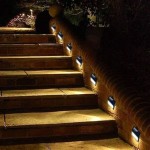Motion Sensors for Lights Outdoor: Essential Aspects to Consider
Motion sensors for outdoor lights offer an array of benefits, including enhancing convenience, safety, and energy efficiency. When choosing and installing these sensors, several crucial aspects should be considered to ensure optimal performance and desired outcomes.
Selecting the Right Type of Motion Sensor
There are various types of motion sensors available for outdoor lights, each offering unique capabilities. Here are the main types to consider:
- Passive Infrared (PIR) Sensors: Detect changes in infrared radiation emitted by moving objects. They are commonly used for residential and commercial applications due to their reliability and cost-effectiveness.
- Microwave Sensors: Utilize microwaves to detect motion by sensing changes in the frequency of reflected waves. They offer wider coverage and better performance in harsh weather conditions.
- Dual-Technology Sensors: Combine both PIR and microwave technologies for increased accuracy and reduced false triggers.
Coverage Zone and Detection Range
The coverage zone and detection range of a motion sensor determine the area it will monitor. Consider the size of the area to be covered and the desired detection distance. Choose a sensor with an appropriate coverage zone to avoid blind spots or excessive triggering.
Sensitivity and Trigger Threshold
The sensitivity of the motion sensor determines how easily it will detect movement. Adjust the trigger threshold to achieve the desired balance between detection accuracy and reducing false triggers. A higher threshold means the sensor will only trigger when a larger or more significant movement is detected.
Mounting Height and Orientation
The mounting height and orientation of the motion sensor will influence its performance. Mount the sensor at an optimal height to minimize false triggers from pets or vegetation. Position the sensor to cover the desired area without obstructing the view.
Weather Resistance and Durability
Outdoor motion sensors must be weather-resistant to withstand harsh environmental conditions such as rain, snow, and extreme temperatures. Choose sensors with IP ratings indicating their protection level against moisture and dust.
Compatibility with Lights
Ensure compatibility between the motion sensor and the outdoor lights to be controlled. Some sensors require specific wiring or voltage requirements. Verify the compatibility before installation to avoid any issues.
Other Considerations
In addition to the essential aspects mentioned above, there are a few other considerations to keep in mind:
- Time Delay: Set the time delay to determine how long the lights will stay on after motion is detected.
- Dimming Capabilities: Some motion sensors offer dimming capabilities, allowing you to adjust the light brightness according to ambient conditions.
- Connectivity: Consider sensors with wireless connectivity options for remote control and integration with smart home systems.

The Best Outdoor Motion Sensor Lights In 2024 Popular Science

Discover The Benefits Of Outdoor Motion Sensor Lights Staysafe Org

Auraglow Pir Motion Sensor Up Down Outdoor Wall Security Light Warminster Stainless Steel Led Lighting

Best Outdoor Motion Sensor Lights 2024 Security

Lepro 20w Security Lights Outdoor Motion Sensor 1700 Lumen Pir Light Ip65 Waterproof Flood

Outdoor Motion Sensor Lights Lamps Plus

Philips Hue Outdoor Motion Sensor Review Macrumors

Defiant 180 Degree Motion Sensor White Outdoor Security Light Df 5416 Wh A The Home Depot

Up And Down Pir Motion Sensor Wall Light For Outdoor Use

Best Motion Detector Lights Of 2024 Safewise







